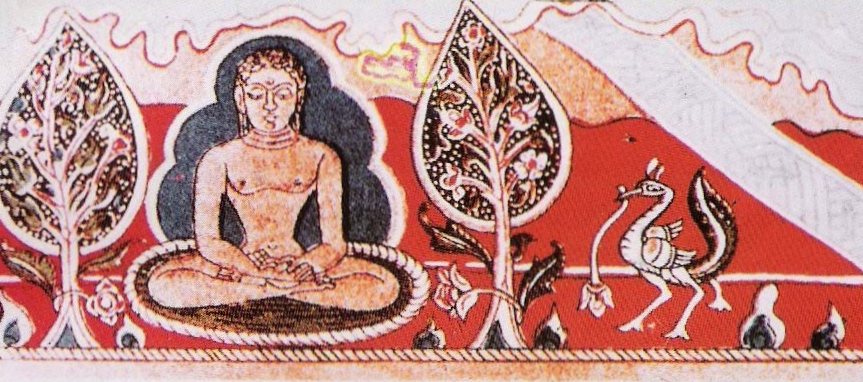

Teachings of Māhavīra
3.0. Worldly
Māhavīra classified his followers in two categories, namely:
- Śramaņas or monks/ ascetics who wish to lead a totally detached life and work 100 percent of their time for the attainment of omniscience and emancipation.
- Śrāvakas or householders / laity who wish to carry on their worldly pursuits but with his teachings in mind and practice and slowly move towards the ideal of leading a monk’s life at some time in future.
For Śrāvakas He asked them to observe 5 mini vows (aņuvratas), six essential duties and avoidance of basic sins from their life. Further he says that we should practice the vows according to our capacity and inclination so that we can practice them comfortably and gradually enhance their severity. Further he talked of practice with confessing one’s nonimplementation of vows and start all over again (chedopasthāniya conduct). The main sermons for common man was to atleast keep his thoughts pure and knowingly not commit any sin.
The prayer, widely known as Meri Bhāvanā (My prayer) by Jugal Kishore Mukhtāra, recited by most of the Jains on regular basis sums up the practice of Māhavīra’s teachings by common men /women.
4.0 Relevance today
As said in the preamble, the state of affairs of the world is similar to what was in Māhavīra’s time except that the knowledge level of material world and the scientific discoveries have given even common men the benefit of prosperity to common man also. Today we are more materialistic in our outlook and feel that accumulation and consumption of wealth is the only way to gain happiness. No doubt material wealth is essential to lead a comfortable life but it is not the all-encompassing cause of happiness. There is a famous saying,” If life were a thing money can buy, the poor wont live and the rich wont die’. We are seeing that material prosperity generates problems of ecology imbalance, economic inequalities, enhanced tension / stress and other so called lifestyle health problems, terrorism, aids and even the fear of extinction of the human race itself. Experience also shows that these problems cannot be effectively solved by materialist outlook only. On the other hand we have seen above that Māhavīra’s teachings can assist us in minimizing, if not eliminating, the ill effects of most of these problems. Mahatma Gandhi used Māhavīra’s teachings effectively in leading his own life as well as solving the problems of the country as a whole. He took the five mini vows for his personal improvement and used the nonviolent path of passive resistance (satyāgraha or holding on the truth)) path to resolve social and national problems. A testament to this is enshrined in the constitution of India as given below:
Vardhamana Mahavir, the 24th Tirthankara in a meditative posture, another illustration from the Calligraphed edition of the Constitution of India, Jainism is another stream of spiritual renaissance which seeks to refine and sublimate man's conduct and emphasises Ahimsa. non-violence, as the means to achieve it. This became a potent weapon in the hands of Mahatma Gandhi in his political struggle against the British Empire.
Jain philosophy as known today is all based on Māhavīra’s teaching. The entire program of the summer school has been designed around his teachings and their use to address today’s problems. Hence you will find details of this paper in different lectures of the program.
Quotations for disciples and laity for day to day life8
- Aņusāsio na kuppejā. 1/9. Do not get angry when disciplined
- Khuddehiń saha sańsaggiń hāsań kidań ca vajjae. 1/9. Do not keep company of bad people. Do not indulge in making fun (cutting jokes) or associated activities.
- Nā puttho vāgare kinci puttho vā nāliyan vaye.1/14. Do not speak unless asked for. And do not tell lie when asked to speak.
- Kohań asaccan kuvejjā 1/14. Suppress (or destroy) anger.
- Appā danto suhī hoe. 1/15. He who gains full control over himself.
- Suī dhammassadullahā. 3/8. It is very difficult to get (hear) religious sermons.
- Sohi ujjuyabhūuyassat. 3/12. He is sacred /holy who is simple.
- Ghorā muhuttā abalań sarirań. 4/6. Time is very cruel and the body very fragile.
- Kammasacchāhu pāņiņo. 7/20. An act performed never goes without results.
- Varań me appā damnto sańjameņa taveņa ya; Māhań parehiń dammanto bandhaņehi vahehiya. It is better that I suppress or destroy my ills (sins) through self-restraint and penance. It is not good that others do so to me through discipline or giving pain.
5. Summary
We can conclude and summarize Māhavīra’s teachings in the four lines as follows:
- Ahińsā in conduct
- Aparigraha in life
- Anekāńta in thoughts
- Syādavāda in speech
Jain philosophy as we know today is all based on Māhavīra’s teachings. The entire program of the summer school has been designed around His teachings and their use to address today’s problems.
References
- Sutrakŗatāńga talks of more than 350 philosophies prevailing at that time.*
- Samana sutam –82
- Dasavaikālika sutra:*
- The first ańga of the 12th ańgas, known as Acārāńga (chapter I), beautifully explains these questions. * Svetambara canonical literature
- Rattankarand Śrāvakācāra by Samanta Bhadra and its commentaries
- Tattvārathasutra by Umā Svāti and its commentaries by Pūjya Pāda and Akalańka.
- Bhagawati, the fifth ańga and first sutra.* Svetambara canonical literature
- Uttradhyana * Svetambara canonical literature
- Other references used.
Kund Kund’s Samayasāra, Pańcastikāya, Pravacanasāra, Sila Pāhuda,
Purūşārthasidhupāya by Amŗatacandra, Mahāprajňa’s literature on Anekānta.*
